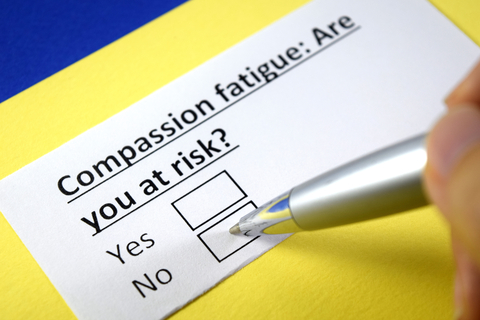Self-care discussions for helping professions frequently involve terms like burnout and compassion fatigue. Sometimes, these discussions imply that these terms are interchangable. But are they really? Previous blog posts have explored burnout. But what is compassion fatigue? Keep reading to learn about compassion fatigue and how it relates to burnout and PTSD.
What Is Compassion Fatigue?
As previously mentioned, people often use the terms burnout and compassion fatigue interchangeably. However, these burnout and compassion fatigue are not the same. Instead, burnout is a key component in determining what is compassion fatigue. But compassion fatigue is not part of burnout.
So what is compassion fatigue then? Compassion fatigue combines the exhaustion and job effects of burnout with PTSD-like symptoms from exposure to secondary stress. In fact, your PTSD-like symptoms can be so significant that they also meet the diagnostic criteria for PTSD. This can happen even if you haven’t experienced trauma directly yourself.
Effects of Secondary Stress
As you go about your job as a helper, you learn about terrible things your patients, clients, or students experienced. This exposure can happen multiple ways. For example, you might hear stories of tragic events happening to those you help long after they’ve happened. Or you might be directly helping with the impact of those events, such as disaster recovery.
Regardless of how you learn of horrific events, these things can start to affect you. You can start feeling jumpy or start worrying that the same thing might happen to you. Sometimes, intrusive images or nightmares start interfering with your day to day life. Then, you do whatever you can to avoid reminders of those things or your patients.
Compassion Fatigue and PTSD
Sometimes, the effects of your exposure to secondary stress can also meet the diagnostic criteria for PTSD. In order for that to happen, you have some kind of reliving symptoms, such as nightmares or intrusive thoughts. You also do things to avoid reminders of the events or the people you help. Additionally, your mood and thoughts change. The world might not feel safe anymore. It might be really hard to think positively about people or yourself. And finally, you have changes in how you react to things. For example, you might not be sleeping, you might be really jumpy, or you might always be watching for danger.
But you can also have both PTSD from your own stuff and from compassion fatigue. In fact, having your own trauma actually puts you at higher risk for compassion fatigue. Likewise, the people you help who have experiences similar to yours can also worsen your pre-existing reactions to your own experiences.
Burnout in Compassion Fatigue
Compassion fatigue includes the same effects as burnout. That is, you feel exhausted and it seems like no amount of time off can quench that exhaustion. Your job performance suffers. And you start making mistakes, some that might even put your job in jeopardy.
Without more information, it would be easy for someone observing to say that you don’t care about your job. But reality is, compassion fatigue results from caring about your job, not the other way around.
Who Is At-Risk for Compassion Fatigue?
If you help people, you are at risk for compassion fatigue. Some careers have a little more built in protection from exposure to secondary stress than others. But ultimately, anytime you help people you run the risk of being exposed to their stories and having the stories affect you.
As an example, therapists, nurses, and paramedics routinely deal with the worst parts of a person’s life. This is a little more unavoidable than a teacher whose primary job functions lie in education rather than crisis intervention. This is not to say that teachers do not get compassion fatigue and do not get exposed to the horrific things their students have experienced. In fact, they do.
Noticeable Symptoms
Compassion fatigue combines symptoms of both PTSD and burnout. But what does that really mean? You will likely notice things like irritability and anger. It might be really hard for you to feel compassion towards the people you help. You might call out of work more often, and when you do show up, your work performance is reduced. Making decisions seems impossible, even if those decisions impact your patients.
The things you used to enjoy don’t help anymore. In fact, there’s not much that you do enjoy. And your coping skills get in the way of healing. Drinking, drugs, and Netflix are your escapes. It’s easier to numb yourself than to face the memories. But that makes you miss out on things with your family and your friends. Your social life suffers.
Healing Compassion Fatigue

Compassion fatigue isn’t going to go away on its own. And you also don’t have to fight it on your own. Treatment for compassion fatigue combines aspects of treatment for burnout and PTSD. You can read more about compassion fatigue treatment at Earthsong Counseling here.
Final Thoughts
In this post, we answered the question, “what is compassion fatigue?” We learned that it’s a combination of burnout with effects of secondary stress. Individuals in any helping profession are at risk for compassion fatigue, and previous experiences with trauma heighten that risk.
If you are concerned that you or someone you love is struggling with compassion fatigue, don’t wait to see if it will “just go away.” It won’t. Be proactive and ask for help as soon as possible





